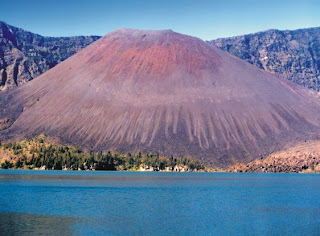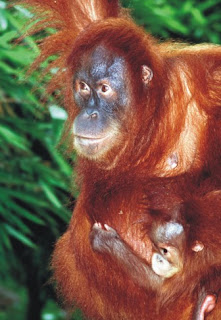anjung Puting National Park has several ecosystem types: lowland tropical rain forest, dryland forest, freshwater swamp forest, mangrove forest, coastal forest, and secondary forest.
The Park is dominated by lowland forest plants like jelutung (Dyera costulata), ramin (Gonystylus bancanus), meranti (Shorea sp.), keruing (Dipterocarpus sp.), and rattans.
Endangered and protected species of animal inhabiting the Park include the orangutan (Pongo satyrus), proboscis monkey (Nasalis larvatus), maroon leaf monkey (Presbytis rubicunda rubida), sun bear (Helarctos malayanus euryspilus), lesser Malay mouse deer (Tragulus javanicus klossii), clouded leopard (Neofelis nebulosa), and leopard cat (Prionailurus bengalensis borneoensis).
The Park is dominated by lowland forest plants like jelutung (Dyera costulata), ramin (Gonystylus bancanus), meranti (Shorea sp.), keruing (Dipterocarpus sp.), and rattans.
Endangered and protected species of animal inhabiting the Park include the orangutan (Pongo satyrus), proboscis monkey (Nasalis larvatus), maroon leaf monkey (Presbytis rubicunda rubida), sun bear (Helarctos malayanus euryspilus), lesser Malay mouse deer (Tragulus javanicus klossii), clouded leopard (Neofelis nebulosa), and leopard cat (Prionailurus bengalensis borneoensis).


This Park was the first place in Indonesia to become a rehabilitation centre for orangutans. There are now three orangutan rehabilitation locations, Tanjung Harapan, Pondok Tanggui, and Camp Leakey.
The orangutan of Kalimantan has dark reddish fur and no tail. As they get older, the adult males cheeks flesh out, resembling cushions. The older they get, the bigger these cheek flanges grow, giving them a fierce look.
UNESCO has declared Tanjung Puting National Park as a Biosphere Reserve, and it is also a Sister Park to Taman Negara Malaysia under a cooperation agreement between Indonesia and Malaysia
Read More......
Interesting locations/attractions:
Tanjung Harapan: this is the first station in the orangutan rehabilitation process. Situated in the midst of secondary forest and swamp forest, it has a guesthouse, an information centre, and trails.
Pondok Tanggui: orangutans that have passed the semi-wild phase are moved to Pondok Tanggui. There, they are closely monitored from a distance, and human contact is avoided.
Camp Leakey: founded in 1971 in the middle of primary forest, this is the location for semi-wild and wild orangutans, and for younger orangutans from birth until three years of age.
Natai Lengkuas: bekantan research station, and watching other animals along the river. Buluh River and Danau Burung ("Bird Lake"): watching birds, in particular migrant species.
Among the cultural attractions outside the Park is a traditional rowing contest held in Pangkalan Bun in May.
Best time of year to visit: June to September.
How to reach the Park: Jakarta-Semarang-Pangkalan Bun by plane, or from Semarang to Pangkalan Bun by ship. Pangkalan Bun-Kumai by car (8 km). Then, Kumai-Tanjung Harapan by motorized longboat, 1.5-2 hours; or Kumai-Natai Lengkuas, 4-5 hours; Kumai-Tanjung Harapan by fast motor boat, 0.5-1 hour; Kumai-Camp Leakey, 1.5-2 hours; or from Kumai-Natai Lengkuas, 1.5-2 hours.
Office: Jl. HM Rafii Km 2 Pangkalan Bun, Kotawaringan Central Kalimantan Tel./Fax. : +62-532-23832
Declared Minister of Agriculture, in 1982,
a total area of 300,000 hectares
Designated Minister of Forestry SK No. 587/Kpts-II/96,
a total area of 415,040 hectares
Location Regency of Kotawaringin (Province of Central Kalimantan)
Temperature 22° - 33° C
Rainfall 2,400 mm/annual (on average)
Altitude 0 - 100 m asl.
Geographical location 111°42' - 112°14' E; 2°33' - 3°32' S
Source : http://www.dephut.go.id
Tanjung Harapan: this is the first station in the orangutan rehabilitation process. Situated in the midst of secondary forest and swamp forest, it has a guesthouse, an information centre, and trails.
Pondok Tanggui: orangutans that have passed the semi-wild phase are moved to Pondok Tanggui. There, they are closely monitored from a distance, and human contact is avoided.
Camp Leakey: founded in 1971 in the middle of primary forest, this is the location for semi-wild and wild orangutans, and for younger orangutans from birth until three years of age.
Natai Lengkuas: bekantan research station, and watching other animals along the river. Buluh River and Danau Burung ("Bird Lake"): watching birds, in particular migrant species.
Among the cultural attractions outside the Park is a traditional rowing contest held in Pangkalan Bun in May.
Best time of year to visit: June to September.
How to reach the Park: Jakarta-Semarang-Pangkalan Bun by plane, or from Semarang to Pangkalan Bun by ship. Pangkalan Bun-Kumai by car (8 km). Then, Kumai-Tanjung Harapan by motorized longboat, 1.5-2 hours; or Kumai-Natai Lengkuas, 4-5 hours; Kumai-Tanjung Harapan by fast motor boat, 0.5-1 hour; Kumai-Camp Leakey, 1.5-2 hours; or from Kumai-Natai Lengkuas, 1.5-2 hours.
Office: Jl. HM Rafii Km 2 Pangkalan Bun, Kotawaringan Central Kalimantan Tel./Fax. : +62-532-23832
Declared Minister of Agriculture, in 1982,
a total area of 300,000 hectares
Designated Minister of Forestry SK No. 587/Kpts-II/96,
a total area of 415,040 hectares
Location Regency of Kotawaringin (Province of Central Kalimantan)
Temperature 22° - 33° C
Rainfall 2,400 mm/annual (on average)
Altitude 0 - 100 m asl.
Geographical location 111°42' - 112°14' E; 2°33' - 3°32' S
Source : http://www.dephut.go.id











